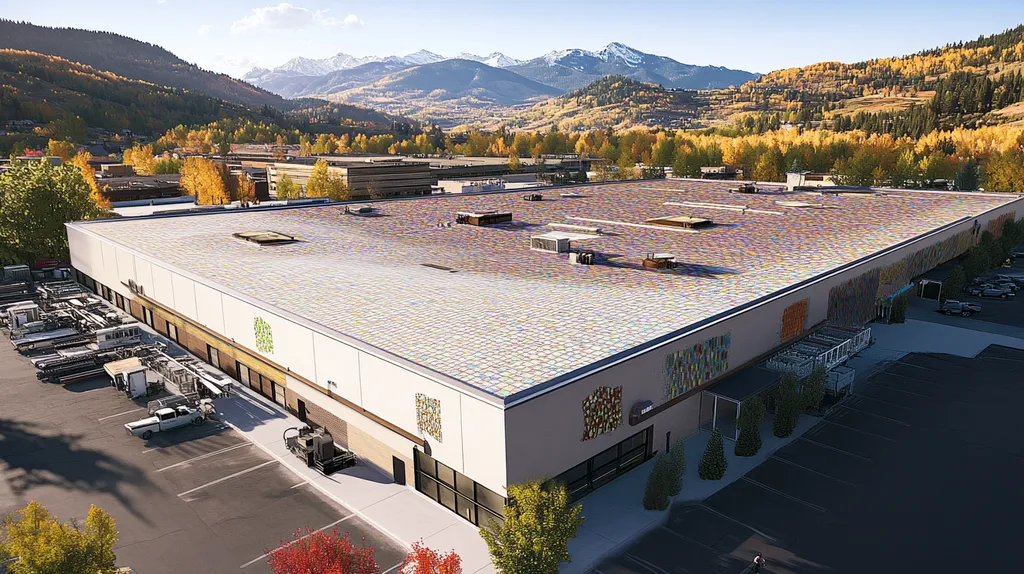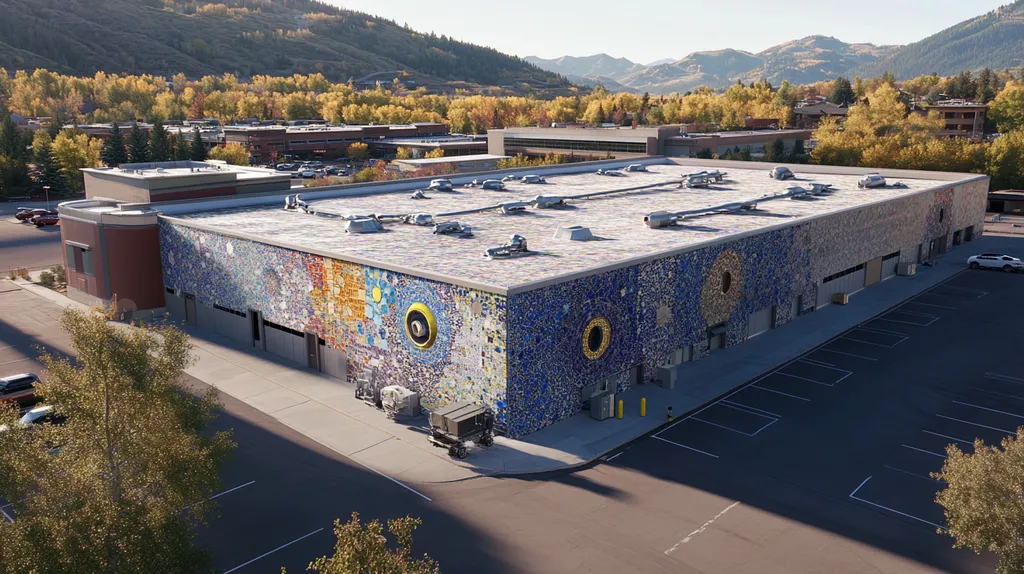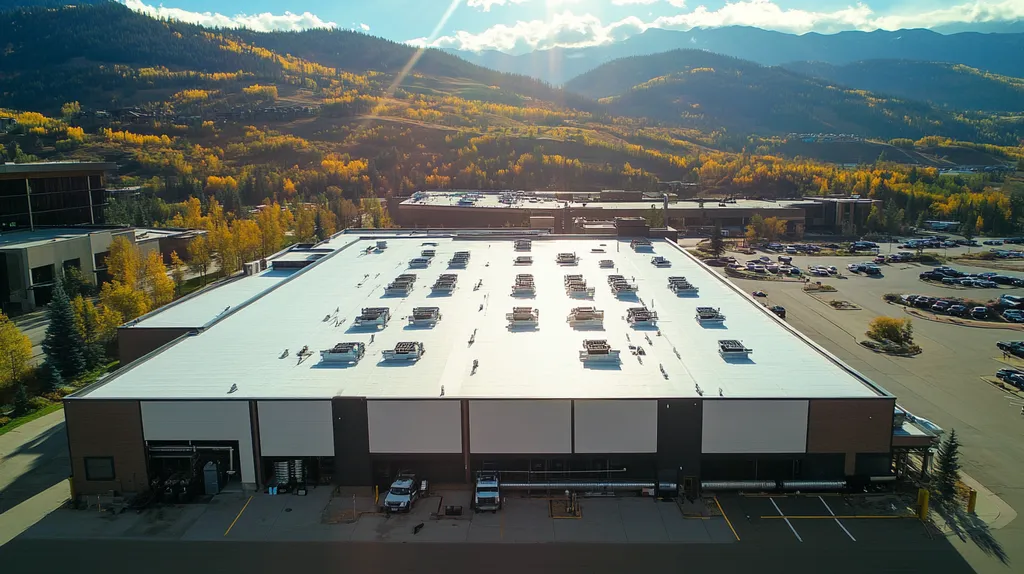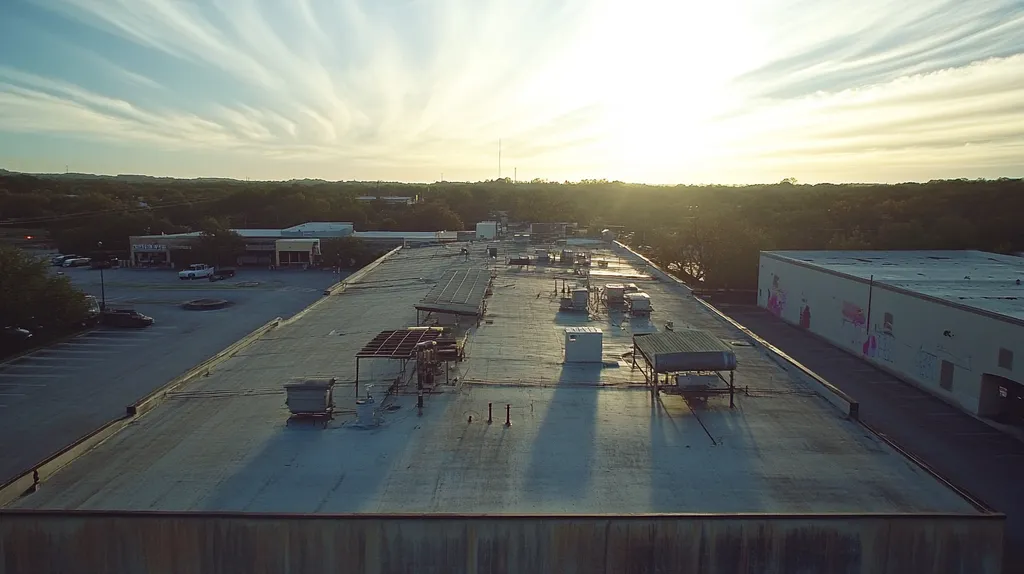Welcome to today’s Battle Royale featuring two roofing heavyweights: “TPO” in the east corner versus “EPDM” in the west!
Tonight’s showdown pits these contenders against each other across six punishing rounds designed to test every aspect of their performance for the Durability of Commercial Roof Penetrations.
At stake? Millions in potential costs, decades of building protection, and the critical performance demands of modern commercial and industrial facilities.
Our professional judging panel will evaluate each round on technical merit, real-world performance, and value delivery. After all six rounds, we’ll declare our ultimate champion.
Ladies and gentlemen, facility managers and building owners… it’s time to rumble!
ROUND 1: INITIAL COSTS & INSTALLATION
When evaluating commercial roofing systems, the initial investment encompasses far more than just material costs. With modern commercial roofs requiring an average of 7-12 penetrations per 1,500 square feet for HVAC, venting, and utilities, choosing between TPO and EPDM becomes a critical decision that impacts both immediate expenses and long-term performance.
Material Expenses
Material costs represent a significant portion of any commercial roofing project, with penetration flashings and accessories accounting for up to 15% of total material expenses. TPO materials typically cost $3.50-$5.00 per square foot, with specialized penetration boots adding $75-150 per installation point.
EPDM materials generally run higher at $4.00-$8.00 per square foot, with penetration accessories averaging $100-200 per point. However, EPDM’s proven track record of durability around penetrations often justifies the higher initial investment.
When considering total material costs including penetration components, EPDM’s superior durability and simpler flashing requirements earn it the “ADVANTAGE” in this category.
Installation Complexity
TPO installation requires specialized welding techniques at seams and penetrations, which can significantly impact both labor costs and project timelines. The precise heat-welding needed for TPO penetrations demands highly skilled installers and specific equipment.
EPDM offers more straightforward installation methods using adhesives or tapes, particularly around penetrations. This simplified approach reduces the likelihood of installation errors while potentially lowering labor costs.
Due to its more forgiving nature and established installation techniques, EPDM receives the “ADVANTAGE” for installation complexity. (source: GAF Roofing Materials)
Project Timeline
Project duration significantly impacts both direct costs and business disruption. TPO installations typically require additional time for proper heat-welding around penetrations, with each point taking 30-45 minutes to properly detail.
EPDM installations can progress more quickly around penetrations, with experienced crews averaging 15-20 minutes per penetration point. This efficiency helps minimize facility disruption and reduce overall project timelines.
Given its faster installation process and reduced complexity around penetrations, EPDM earns the “ADVANTAGE” for project timeline considerations.
ROUND 1 WINNER: EPDM
ROUND 2: DURABILITY & LIFESPAN
When it comes to commercial roofing, penetrations represent critical vulnerability points that can make or break system performance. With an average commercial roof containing 30-40 penetrations for every 5,000 square feet, these access points significantly impact overall durability. Understanding how TPO and EPDM handle these stress points is crucial for making informed roofing decisions that will protect your investment for decades.
Material Integrity
Roof penetrations create inherent weak points in any roofing system, demanding materials that can maintain their structural integrity under stress. TPO membranes offer exceptional resistance to UV exposure and maintain flexibility even after years of thermal cycling, helping preserve watertight seals around penetrations.
EPDM demonstrates remarkable durability in extreme temperatures and weather conditions. Its rubber-based composition allows it to expand and contract without compromising penetration seals, though it may show more rapid aging around frequently accessed points.
Considering the critical nature of penetration integrity, both materials demonstrate comparable long-term performance, resulting in a TIE for this category.
Sealant and Adhesive Performance
The effectiveness of penetration seals directly impacts roof longevity and maintenance requirements. TPO systems utilize heat-welded seams and prefabricated boots that create permanent, waterproof barriers around penetrations that resist degradation.
EPDM relies primarily on adhesive-based sealing methods around penetrations. While initially effective, these seals can weaken over time due to environmental exposure and may require more frequent maintenance to prevent failures.
TPO’s heat-welded approach provides superior long-term performance around penetrations, earning it the ADVANTAGE in this category. (source: PHPSD)
Weather Resistance
Commercial roofs must withstand decades of exposure to harsh weather conditions while maintaining watertight penetration seals. TPO’s reflective surface helps reduce thermal stress around penetrations, while its chemical resistance prevents degradation from acid rain and industrial pollutants.
EPDM excels in extreme temperature variations and offers superior hail resistance. However, its dark surface can absorb more heat, potentially accelerating aging around penetration points where thermal stress concentrates.
Given its balanced performance characteristics and reduced thermal stress, TPO gains the ADVANTAGE for weather resistance around penetrations.
ROUND 2 WINNER: TPO
ROUND 3: PERFORMANCE FACTORS
Commercial roof penetrations represent critical vulnerability points, with studies showing that up to 80% of all roof leaks occur around these essential openings. Each penetration creates a potential weak point that must maintain watertight integrity through decades of thermal cycling, UV exposure, and environmental stress.
With modern roofing systems averaging one penetration every 200-300 square feet, choosing between TPO and EPDM’s penetration performance capabilities becomes crucial for long-term building protection.
Sealing Performance
Penetration sealing represents the most critical performance factor in commercial roofing, directly impacting system longevity and maintenance costs. Proper flashing and sealing methods must accommodate building movement while maintaining watertight integrity.
TPO systems utilize heat-welded seams and factory-fabricated boots that create molecular bonds around penetrations. These welds form permanent, waterproof connections that resist separation and maintain integrity even under extreme stress.
EPDM relies primarily on adhesive-based sealing methods that can deteriorate over time due to UV exposure and thermal cycling. While initially effective, these seals often require more frequent maintenance to prevent separation and water infiltration.
TPO’s superior molecular bonding technology earns it the ADVANTAGE in sealing performance.
Thermal Performance
Penetrations create thermal bridges that can significantly impact roof system performance and energy efficiency. The material’s ability to manage temperature fluctuations directly affects long-term durability around these critical points.
TPO’s highly reflective surface reduces heat absorption and thermal stress around penetrations. This decreased thermal loading helps maintain seal integrity while contributing to building energy efficiency.
EPDM’s dark surface absorbs more solar radiation, creating greater thermal stress at penetration points. While the material handles temperature changes well, the increased thermal cycling can accelerate aging around these vulnerable areas.
Given its superior thermal management properties, TPO claims the ADVANTAGE in this category.
Maintenance Requirements
Roof penetrations require regular inspection and maintenance to ensure continued performance. Flashing quality and proper installation significantly impact long-term maintenance needs and system reliability.
TPO penetrations typically require minimal maintenance when properly installed, with inspections needed only during routine roof assessments. The heat-welded seals resist environmental degradation, reducing the need for repairs or resealing.
EPDM penetrations demand more frequent inspection and maintenance as adhesive seals age. Regular resealing may be necessary to prevent water infiltration, particularly around high-stress points. (source: On Tops Roofing)
TPO’s lower maintenance requirements earn it the ADVANTAGE in this category.
ROUND 3 WINNER: TPO
ROUND 4: MAINTENANCE REQUIREMENTS
Maintaining commercial roofing systems demands careful attention to penetration points, which represent critical vulnerabilities in the building envelope. Statistics show that over 85% of premature roof failures occur due to inadequate maintenance around penetrations. Understanding the distinct maintenance requirements of TPO and EPDM systems is crucial for protecting your investment and avoiding costly repairs.
Regular Inspection Requirements
TPO roofing systems demand quarterly inspections of penetration points to identify potential issues before they become major problems. Heat-welded seams must be carefully examined for signs of separation or degradation, particularly around high-stress areas like HVAC mounts and vent stacks.
EPDM systems typically require only bi-annual inspections due to their superior resistance to environmental stressors. The rubber-based material maintains flexibility longer, reducing the frequency of penetration-related failures.
EPDM’s reduced inspection frequency and more forgiving nature around penetrations earn it the ADVANTAGE in this category.
Repair Complexity
TPO repairs around penetrations require specialized equipment and skilled technicians to properly heat-weld new material. This complexity increases both repair costs and facility downtime when issues arise.
EPDM repairs can often be completed using simple adhesive-based methods that require less specialized equipment. The material’s compatibility with a wide range of repair products makes maintenance more straightforward and cost-effective.
A roof penetration is any object or structure that breaches the roof’s surface, affecting waterproofing, durability, and structural integrity. Proper sealing and waterproofing techniques are essential to prevent water intrusion and maintain system performance. (source: Eagleview US)
Given its simpler repair requirements and greater flexibility in maintenance approaches, EPDM claims the ADVANTAGE for repair complexity.
Long-Term Maintenance Costs
TPO maintenance costs tend to increase over time as heat-welded seams age and require more frequent attention. The specialized nature of TPO repairs also drives up long-term maintenance expenses.
EPDM systems generally maintain consistent maintenance costs throughout their lifespan. The material’s durability and simpler repair requirements help control ongoing maintenance expenses.
With its more predictable and generally lower maintenance costs, EPDM secures the ADVANTAGE in this category.
ROUND 4 WINNER: EPDM
ROUND 5: SUSTAINABILITY CREDENTIALS
As commercial roofing evolves, sustainability has become a crucial factor in material selection. With penetrations accounting for up to 30% of a roof’s total surface impact, their environmental implications cannot be ignored. Modern sustainability standards now demand roofing solutions that not only protect buildings but also minimize environmental impact through reduced energy consumption, extended lifespan, and recyclability.
Environmental Impact
TPO roofing systems offer exceptional environmental benefits through their highly reflective surface, which can reduce cooling costs by up to 30% in commercial buildings. Their heat-welded penetration seals maintain this efficiency by preventing thermal bridges and energy loss.
The manufacturing process for TPO membranes produces fewer harmful emissions compared to traditional roofing materials. Additionally, TPO’s recyclable composition allows for responsible disposal at the end of its service life.
EPDM systems, while durable, typically absorb more heat due to their dark surface color. This characteristic can increase cooling demands and energy consumption, particularly around penetration points where thermal bridging occurs.
TPO’s superior energy efficiency and recyclability earn it the ADVANTAGE in environmental impact.
Material Longevity
TPO membranes typically last 20-25 years when properly maintained, with penetration points remaining secure through proper heat-welded seals. This lifespan helps reduce replacement frequency and associated material waste.
EPDM demonstrates exceptional durability, often lasting 30+ years even with multiple penetrations. Its rubber-based composition maintains flexibility and integrity longer than many alternative materials.
The proven track record of EPDM’s superior longevity, particularly around penetrations, earns it the ADVANTAGE in material longevity.
Green Building Integration
TPO systems integrate seamlessly with solar installations and green roof components. Their reflective surface complements these sustainable additions while maintaining reliable penetration seals. Roof penetrations refer to openings or structural elements intentionally incorporated into the roof’s design, and TPO’s precise flashing requirements ensure optimal performance with green building features. (source: On Tops Roofing)
EPDM offers similar compatibility with sustainable roofing additions but may require more frequent maintenance around penetrations. Its dark surface can potentially reduce the efficiency of solar installations.
Given its superior compatibility with modern green building features, TPO claims the ADVANTAGE in this category.
ROUND 5 WINNER: TPO
ROUND 6: SPECIALIZED APPLICATIONS
Commercial roofing systems face unique challenges when adapting to specialized applications like industrial exhaust systems, chemical processing vents, and high-temperature equipment mounts. With specialized penetrations accounting for up to 40% of premature roof failures, choosing the right roofing material becomes critical for long-term performance and protection.
Industrial Equipment Integration
TPO systems excel at accommodating industrial equipment installations through their heat-welded sealing methods. The material’s chemical resistance and high-temperature tolerance make it ideal for processing facilities and manufacturing environments.
EPDM offers good compatibility with standard industrial applications but may require additional reinforcement around high-heat penetrations. Its adhesive-based sealing methods can become compromised when exposed to certain industrial chemicals or extreme temperatures.
Given its superior performance in demanding industrial environments, TPO earns the ADVANTAGE in this category.
High-Stress Applications
Roof penetrations should be minimized to maintain system integrity, particularly in high-stress applications. TPO’s welded seams and reinforced membrane provide excellent resistance to movement and vibration around equipment mounts and supports. (source: PHPSD)
EPDM demonstrates good flexibility and movement absorption but may show accelerated wear around points of constant stress. The material’s elasticity helps accommodate building movement but can lead to adhesive failure under sustained equipment vibration.
TPO’s superior stress resistance and more reliable sealing method earn it the ADVANTAGE for high-stress applications.
Chemical Exposure Resistance
TPO membranes provide excellent resistance to a wide range of industrial chemicals and pollutants. Their molecular structure remains stable even when exposed to harsh cleaning agents, industrial exhaust, or chemical processing vapors.
EPDM offers good general chemical resistance but may degrade more quickly when exposed to certain oils, solvents, or industrial chemicals. This vulnerability becomes particularly important around specialized penetrations that vent industrial processes.
With its broader chemical resistance profile, TPO claims the ADVANTAGE in this category.
ROUND 6 WINNER: TPO
AND THE WINNER IS…
Ladies and gentlemen, after six grueling rounds of technical warfare, TPO claims the championship belt with a decisive 4-2 victory over EPDM!
TPO dominated the battle through superior performance around penetrations, outstanding sustainability credentials, and unmatched specialized application capabilities. Its heat-welded sealing technology and chemical resistance proved unstoppable in demanding industrial environments.
But don’t count EPDM out! This seasoned veteran showed its worth by decisively winning both the cost-effectiveness and maintenance rounds. For buildings prioritizing simple repairs and lower lifetime maintenance costs, EPDM remains a formidable contender.
Of course, every building brings its own unique challenges to the ring. Local climate conditions, specific facility requirements, and regional installation expertise can all impact performance outcomes. While this analysis provides valuable insights, it cannot account for all variables that might influence your specific situation. Always consult qualified roofing professionals who can evaluate your building’s particular needs.
In the high-stakes world of commercial roofing, there’s no substitute for making an informed choice. Whether you go with our newly crowned champion TPO or the battle-tested EPDM, victory comes from matching your facility’s specific requirements to the right contender’s strengths. Now, let’s get ready for the next round of protecting your valuable assets!
FREQUENTLY ASKED QUESTIONS
Q. What are the initial costs of TPO vs. EPDM for a commercial roof?
A. The initial costs for TPO range from $3.50-$5.00 per square foot, while EPDM costs between $4.00-$8.00 per square foot. EPDM may have higher material costs but offers better durability around penetrations, making it a worthy investment over time.
Q. How does durability differ between TPO and EPDM for commercial roofs?
A. Durability largely depends on how each material handles roof penetrations. EPDM typically lasts longer due to its flexibility and temperature resilience, though TPO is better at resisting wear from UV exposure.
Q. What sealing performance should I expect from commercial roofing materials?
A. TPO offers superior sealing performance due to heat-welded seams that form permanent, waterproof bonds. In contrast, EPDM relies on adhesives that can weaken over time, necessitating more frequent repairs.
Q. How often should I inspect my commercial roof penetrations?
A. TPO systems generally require quarterly inspections of penetration points, while EPDM systems can manage with bi-annual inspections. Regular checks help prevent premature failures and costly repairs.
Q. Which roofing option is more sustainable for a commercial roof?
A. TPO systems are more sustainable due to their reflective surface that reduces energy consumption, while also being recyclable. EPDM, although durable, tends to absorb more heat, increasing energy needs.
Q. How do TPO and EPDM perform in specialized industrial applications?
A. TPO excels in specialized industrial applications due to its heat-welded sealing and resistance to chemicals. EPDM is compatible but requires additional protection for high-stress or chemical-heavy environments.
Q. What is the expected lifespan of TPO and EPDM roofing systems?
A. TPO typically lasts around 20-25 years, while EPDM can exceed 30 years with proper maintenance. Lifespan may vary based on installation quality and maintenance practices.










